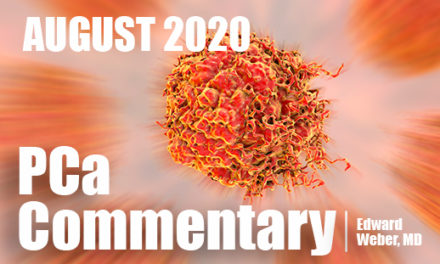
PCa Commentary | Volume 135 – June 2019
Posted by Edward Weber | June 2019
Managing PSA Recurrence Following Primary Radiation Therapy: Evolving Regimens for Focal Treatment
Biochemical recurrence following primary irradiation is relatively common. “A recent series of 2694 patients treated with doses above 78 Gy revealed 10-year biochemical recurrence risks of approximately 10%, 23%, and 44% in low-, intermediate-, and high-risk patients, respectively. […] After primary whole-gland radiotherapy several series showed that nearly all recurrences (89-100%) regrow at the site of the primary largest and/or highest-grade index lesion,” as quoted in “Focal Salvage Treatment of Radiorecurrent Prostate Cancer”, Marieke et al., Cancers (Basel). 2018 Dec. [An excellent review] This biology offers carefully selected patients the opportunity of treatment focused on the control of the local disease recurrence. Treatment of this sort offers the significant benefit of providing the option of delaying or entirely avoiding androgen suppression with its well-recognized toxicities and propensity to induce castration resistance.
Right up front, however: “Management of prostate cancer relapses after external beam radiotherapy is still undefined,” Janoray et al., Cancer Radiotherapy, June 2016 — and this is still true in 2019.
The current standard of care for biochemical recurrence is androgen deprivation therapy (ADT), variously prescribed as continuous or intermittent. ADT may be initiated based on the rate of PSA doubling time, e.g., <6 or <9 months or possibly when the PSA exceeds a threshold target such as 5 – 10 ng/ml — both options being arbitrarily set.
Currently only a very small percentage (~2%) of men receive ‘focused’ treatment of local in-gland recurrence (including the seminal vesicles). This Commentary will discuss the various treatments for local recurrence: cryotherapy, brachytherapy, high-intensity focused ultrasound (HIFU) and stereotactic radiotherapy (CyberKnife). In the past, recurrences have been treated by including the entire gland, but focal therapy in most treatments has been shown to cause fewer adverse effects.
Defining ‘Local’ Recurrence:
The new molecular imaging techniques, i.e., 68-Gallium-PSMA-11 PET (MRI or CT) or the Medicare-approved 18F-fluciclovine metabolic scan (Axumin), are significantly more sensitive compared to traditional imaging such as CT or technetium bone scanning. Studies that employ these scans significantly underestimate the presence of metastatic disease. Currently, biochemical failure (i.e. PSA relapse after primary therapy) is declared at a PSA value of >0.2 ng/mL following surgery or a PSA of 2 ng/mL above the lowest post treatment PSA following radiotherapy (Phoenix definition). The more sensitive scans clearly show that metastatic spread in many instances has occurred well below these metrics, and provide a more accurate assessment of early metastases.
The multiparametric MRI (or biparametric MRI, which eliminates the ‘contrast enhanced’ element) provides the most accurate indication of the location and size of cancer within and around the prostate. Additionally, it can suggest the Gleason grade of the ‘index lesion’. MRI is an important component of establishing local recurrence.
Current management of biochemical failure — The Pro and Con:
An adverse consequence of ADT is exposure to all the unwanted side effects of a low testosterone level, including its suggested induction of castration resistance. The benefits of ADT are peremptorily treating disease sites of a size below current levels of detectability, prolonging metastasis-free survival, delaying the onset of symptoms related to metastases, and providing psychological comfort. However, an early classic study by Dr. Pat Walsh, prominent surgeon at Johns Hopkins, found no survival advantage for hormone suppression prior to the diagnosis of metastases. If his study had employed current sensitive imaging modalities, metastases would have been diagnosed earlier.
What are the requisite elements for establishing truly local recurrence?
There are at least three requirements to reach the optimal treatment outcome for truly local recurrence post radiotherapy:
- establish that the recurrent cancer is indeed local using current state-of-the art imaging, i.e., PSMA PET/CT or Axumin PET/CT;
- localize and confirm the recurrence with a targeted biopsy based on a multiparametric MRI; and
- employ a treatment technique that has the ability to sharply focus on the area of interest so as to minimize collateral tissue damage.
The PSMA PET Scan: The high detection sensitivity of this scan was highlighted in the recent publication by a group of researchers from UCSF: “Single-Center Prospective Evaluation of 68Ga-PSMA-11 PET in Biochemical Recurrence of Prostate Cancer,” Lawhn-Heath et al., Nuc Med & Mol Imaging, Feb 2019. In this study 25.5% were Gleason score 3+4; 25.5% GS 4+3 and 35% were GS > 4+4. “The mean +/- SD time from initial therapy to imaging was 5.9 +/- 4.8 years.”
Based on imaging in 150 men, the sensitivity for detecting any PSMA-positive foci — within or beyond the pelvis — was 55.6% and 60% for PSA values of <0.5 and 0.5 – 1.0 ng/mL. At PSA values of 1 – 2 and 2 – 5 ng/mL, the detection rates rose to ~80% and ~90%.
The AXUMIN PET/CT Scan: A multi-national consortium addressed the diagnostic performance of the Axumin scan at biochemical recurrence. The study was comprised of men with intermediate- and high-risk (D’Amico) cancer; median PSA 2 ng/mL. At a PSA value of <0.79 ng/mL disease was imaged in the prostate or prostate bed ~14% and beyond the pelvis in 30%. At PSA values between 0.8 – 2.03 ng/mL, the values were ~22% and 45%, respectively.
Both studies establish the importance of using either scan in the selection of men for focal treatment.
What is the success rate for local treatment of radiorecurrent prostate cancer expressed as the rate of biochemical failure-free survival (bFFS)?
Executive Summary: “Studies that report five-year bFFS seem to reach an approximate 50% rate,” (Marieke, Ibid). The data below is cited only to show representative results from a few small trials derived from Marieke Table 1, listed as type of treatment, number of patients, bFFS, and significant GU toxicity. In most cases no ADT was used.
Treatment
LDR brachytherapy
LDR brachytherapy
Cryotherapy
Cryotherapy
Cryotherapy
HIFU
#pts
n-12
n-29
n-25
n-65
n-117
n-81
bFFS GU toxicity
78% at 4 years
60% at 3 years
54% at 5 years
54% at 5 years
45% at 5 years
53% at 5 years
GU toxicity
No grade 3 GU toxicity
5% grade 3 GU toxicity*
No incontinence or fistulae
6% incontinence
4.7% recto-urethral fistula
3.7% recto-urethral fistula
* (one urethral stricture); increase in urinary symptoms
Details of three Representative Studies for HIFU, Low-Dose Brachytherapy and CyberKnife
- A report by Kanthabalan et al., (University College London), is an example of a well-performed study: “Focal Salvage High-Intensity Focused Ultrasound in Radiorecurrent Prostate Cancer: (University College London), BJU Int, Mar 2017. In men (150) with intermediate- and high-risk men (~40% each) the site of prostate cancer within the gland was identified with a multiparametric MRI and a MRI-targeted biopsy. Metastatic spread was ruled out as best possible with a choline PET/CT and a technetium bone scan. The median pre-salvage HIFU PSA was 5.5 ng/mL (3.6-7.9) and the median PSA nadir after salvage was 0.67 ng/mL. Median follow-up was 35 months.
Study findings: At 3 years, Kaplan-Meier estimates for freedom from biochemical failure were 61% for the intermediate risk cohort and 32% for high-risk. No ADT was administered after salvage. Urinary infections occurred in 11.3%, bladder neck stricture, 8%; recto-urethral fistula, 2% (3/150). The best outcomes were seen in men with a PSA doubling time of >12 months and pre-salvage PSA of 5 ng/mL or less.
- A report by Peters et al., Radiotherapy and Oncology, 2015 (#2 in the list above) is an example of a well-performed LDR brachytherapy trial. Patients were carefully selected through MRI localization and biopsy to confirm local disease, and in 50% on the basis of choline PET/CT for exclusion of metastatic disease. The median pre-salvage PSA was 4.7 ng/mL; 75% of patients were intermediate- or high-risk; median PSA doubling time was 19 months (only two <10 months). Five initially potent patients retained potency during follow-up. No ADT was used until biochemical failure.
- A recent report by an Italian group, Jereczek-Fossa et al., British Journal Radiology, Feb 2019, reported outcome for 45 men treated with stereotactic body radiotherapy therapy (SBRT – largely CyberKnife) for isolated in-prostate recurrence after primary radiotherapy. Patient selection was based on MRI localization, a rising PSA, and biopsy if necessary. Metastases were ruled out with [11C]-choline PET/CT. The median PSA prior to salvage CyberKnife was 4.29 ng/mL; median time from primary treatment to salvage was 102 months (range, 23 – 208). No ADT was administered to 35 men and for those treated with ADT the median duration was 15 months.
Forty-one men received radiation to the whole gland and in four men radiation was limited to the site of recurrence. The median follow-up was 26.1 months. The projected treatment was 5 daily fractions yielding a total dose of 30 Gy, giving a biological equivalent dose (BED) of 130 Gy.
Some men received a lesser dose.
Study Findings: For the men receiving at least 130 Gy the 5-year progression-free survival was ~43% and local control was ~50%. Specifically, based on 41 patients, 9 (33%) had PSA relapse only; 8 (30%) relapsed in the prostate; 5 (18%) elsewhere in the pelvis; and 3 (11%) developed metastases.
The notable outcome of CyberKnife treatment was the low occurrence of adverse effects, which were generally better than for other treatment modalities. One significant (Grade 3) acute, urinary complication occurred; in 20 patients followed for more than 36 months only one late Grade 3 urinary toxicity occurred (reduction in urinary bladder capacity). No significant bowel adverse effects were reported.
Their Conclusion: “Salvage SBRT for isolated local PCa recurrence is a safe, feasible and noninvasive salvage treatment. […and offers] a satisfactory tumor control and an excellent toxicity profile, if BED > 130 Gy is administered.”
BOTTOM LINE:
By careful patient selection based on optimal imaging techniques combined with highly focused treatment, a select group of men with locally recurrent disease following primary radiotherapy can gain good tumor control and have the option to delay or possibly avoid hormone suppression therapy.
Your comments and requests for information on a specific topic are welcome e-mail ecweber@nwlink.com.
Please also visit https://prostatecancerfree.org/prostate-cancer-news for a selection of past issues of the PCa Commentary covering a variety of topics.
“I want to thank Dawn Scott, Staffperson, Tumor Institute Radiation Oncology Group, & Mike Scully, Librarian, Swedish Medical Center for their unfailing, timely, and resourceful support of the Commentary project. Without their help this Commentary would not be possible.”
ABOUT THE AUTHOR
Edward Weber, MD, is a retired medical oncologist living in Seattle, Washington. He was born and raised in a suburb of Reading, Pennsylvania. After graduating from Princeton University in 1956 with a BA in History, Dr. Weber attended medical school at the University of Pennsylvania. His internship training took place at the University of Vermont in Burlington.
A tour of service as a Naval Flight Surgeon positioned him on Whidbey Island, Washington, and this introduction to the Pacific Northwest ultimately proved irresistible. Following naval service, he received postgraduate training in internal medicine in Philadelphia at the Pennsylvania Hospital and then pursued a fellowship in hematology and oncology at the University of Washington.
His career in medical oncology was at the Tumor Institute of the Swedish Hospital in Seattle where his practice focused largely on the treatment of patients experiencing lung, breast, colon, and genitourinary cancer and malignant lymphoma.
Toward the end of his career, he developed a particular concentration on the treatment of prostate cancer. Since retirement in 2002, he has authored the PCa Commentary, published by the Prostate Cancer Treatment Research Foundation, an analysis of new developments in the prostate cancer field with essays discussing and evaluating treatment management options in this disease. He is a regular speaker at various prostate cancer support groups around Seattle.





